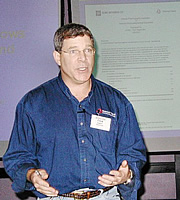Quick Guide: Windows Mobile Software and Pocket PC’s - How PDAs save companies millions – and how they can work for you by Focusing on Data Augmentation,not just Office Automation
Fred Colbert, President
Cert. Level III
Colbert Infrared Services, Inc.
929 19th Avenue
Seattle, WA 98122
Tel: 206-568-4431 / Fax: 206-568-4437
www.ThermalTrend.com
www.colbertinfrared.com
Abstract
Today, mobilizing Thermographers with Pocket PCs is benefiting the infrared industry in ways never imagined just a few years ago. The Pocket PC’s impact has shown up “on, as well as in” IR cameras, and as stand alone Pocket PCs coupled with bar code scanners, and running IR PdMinspections databases with augmented user interfaces for automated data entry and retrieval.
The operating system for the Pocket PC is very friendly and simple, making the roll out of Pocket PCs to your workforce very easy with no extensive training required. Virtually a pick up and go device, at a price of $250.00 US or less, they are a smart hardware platform to mobilize your infrared thermographers.
Simple Fact: Infrared cameras produce a lot of data. The typical report generation time ratio of a professional thermographer of in the field inspection time vs. in the office report generation time is 2 to 1. Eight hours in the field equals four hours of post inspection report generation time.
The future has never looked brighter for the easy to implement methods for the office automation and automated data collection in the field, allowing thermographers to spend less time typing up reports. Thereby decreasing down time of thermographer and IR programs, while increasing by 50% or greater, the up time availability of additional services. However, for the benefits of using a Pocket PC to be fully recognized, the focus must not be placed on just the office automation and data collection, but on how the data is presented to the thermographer on the Pocket PC during their inspection.
The principal of how the data is presented / augmented is more that just a slick user interface (UI), because if it’s not the right information at the right time in the work flow that’s easy and intuitive to work with, then the benefit of office automation and automating the data collection in the field will be completely lost.
The focus must be placed on a knowledge delivery system, not on a data delivery system, whose primary focus is on presenting the data in a meaningful and useful way that will be of benefit to the thermographer in the field, enriching him with not just data, but with valuable information and knowledge during the inspection.
This paper covers the benefits to the thermographer in the field and the IR program of utilizing Pocket PCs and database with an intuitive user interface designed for how thermographers do their job in the field.
-
Data collection (input, edit, omit and delete) of equipment and items / problems.
-
Review, of route / equipment inspection items to be tested, as well as past items / problems.
-
Reconciliation, updating the past items / problems that have been found.
A major emphasis of an IR program is placed on the professional accountability of the
thermographer, their testing methods and the information that is gathered into the report, to ensure that not highest standards are set, but that nothing less is acceptable when we consider the consequences that something got missed. No one can afford missing a single problem that potentially leads to a catastrophic failure.
Pocket PC’s Today
 |
The Pocket PC is revolutionizing the way that people work with data on the go. The computer industry is expecting that in 2004, more Pocket PCs will be sold then conventional computers, and they are ramping up to the technology. For example, Dell, Toshiba, and HP all have Pocket PCs selling for under $250.00 US. The standard, off the shelf, Pocket PC comes with a complete set of standard Microsoft Office applications including Word, Excel, Outlook, Internet Explorer, Media Player, Voice Recorder, etc., and fantastic hand writing recognition software that allows for fast and easy data input and editing. Microsoft ActiveSync software comes with every Pocket PC, which allows you to automatically synchronize the data files on your Pocket PC with your desktop computer so that information is easily transferred between the two devices seamlessly. The Pocket PC platform also allows for the ability to install additional software and hardware integration like bar code scanners or GPS navigation systems. Additional features of the Pocket PC platform is the utilization of technologies like Blue Tooth and Wi-Fi for data transfer and wireless internet-intranet network connections, as well the Pocket PC Phone that integrates the features of the Pocket PC with a cell phone. Clearly, as thermographers, we must look at how this technology can be put to the best use, capitalizing on the advantages that these devices offer in the way of office automation and data collection, but we must be vigilant in making sure that we implement them in the correct way to maximize their benefits. Understanding not just the differences between office automation, automated data collection and data augmentation, but also their strengths and weaknesses is the key to successfully utilizing the Pocket PC for thermographers. |
 |
Presentation of data is vital to a workable solution to office automation and data collection.
|
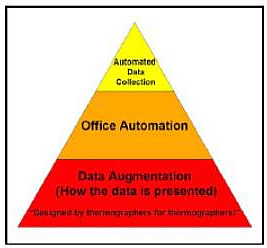 |
Yesterday…
Technology made great strides with the introduction of the Personal Computer (PC) and the ability of IR cameras to digitally store the IR image. This has allowed us the ability to replace Polaroid film and videotape of yesterday’s IR cameras with a Flash memory card and the typewriter with the computer.
Many of today’s IR programs utilizing computers are actually based on the old “Paper Work” flow model of how paper forms flow through the office for report generation. Programs like Word, Excel, or IR report generation software are methods of Office Automation. “Office automation’s focus is about automating the paperwork of secretaries” (Doug Engelbart…1968 The introduction of digital text editing, and the birth of office automation).
It has become much easier to fill in forms and generate a report on a computer as compared to using a typewriter since you can easily go back into the form/report and correct spelling mistakes and insert the digital images and thermograms into the document.
With a portable notebook computer, pen tablet, or even a Pocket PC, and programs like
Microsoft’s Word and Excel, the thermographer can go out into the field and start the office automation and data collection process by entering the data directly into the report forms or templates. However, this will only bring the work that is normally done in the office, out into the field for the thermographer to do while he is doing his inspection. Although typing up the report in the field helps to reduce the amount of report generation time back at the office, it does not help the thermographer do his job better while performing the inspection if it is not implemented correctly.
The key problem is that porting office applications to the small screen Pocket PC does not work to the thermographer’s advantage. The work flow of a thermographer while he is performing an inspection in the field will not match up with the work flow of someone typing up a report back in the home office. Thermographers have specific needs in the field regarding the way that the information needs to be structured so that they can gain quick and easy access to the data.
Implementation of data on a non-augmented user interface
for the small screen size of a Pocket PC:
Examples of paper work flow designs in software and database programs are ones that require you to 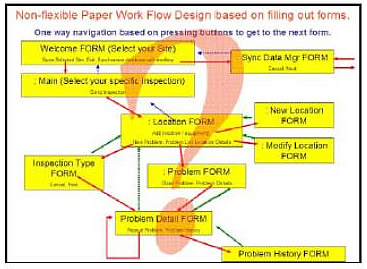 open up a window/form, type your information into the form and press a button to move on to the next window/form. These fixed designs are typically based on the underlying premise to force you to fill out forms, without taking into consideration the needs of the thermographer’s flexible working patterns and the need to present, review, reconcile, enter and edit critical data in an intuitive manner during the inspection. Anyone can port office applications over to a Pocket PC to be used in the field for office automation, but that is really missing the point. The key is that just filling out fields on computerized forms in the field is not a workable solution for thermographers. It’s like having some computer geek telling you…how to do your job!
open up a window/form, type your information into the form and press a button to move on to the next window/form. These fixed designs are typically based on the underlying premise to force you to fill out forms, without taking into consideration the needs of the thermographer’s flexible working patterns and the need to present, review, reconcile, enter and edit critical data in an intuitive manner during the inspection. Anyone can port office applications over to a Pocket PC to be used in the field for office automation, but that is really missing the point. The key is that just filling out fields on computerized forms in the field is not a workable solution for thermographers. It’s like having some computer geek telling you…how to do your job!
An augmented user interface presents data in the way that thermographers do their job…
Although the natural migration for office automation is from the desktop computer to the Pocket PC to automate data collection in the field, the real focus must be placed on data augmentation for the benefit of the thermographer and the IR program. It is easy to port over the Microsoft Word, Excel or a database, based on paper flow model of forms to be filled out in the field, but you are really missing the most important advantage of having the Pocket PC in the field…. It’s the way the data can be “presented” or augmented to the thermographer help them do their job better and with less effort! It’s in building a system that works with the thermographer and provides him with the information when and where it’s needed.
Small screen size is either a blessing or a curse!
A thermographer needs the ability to see what equipment is to be tested and where it is located, check off what has been tested, and review the past problem history of any piece of equipment to see if it has 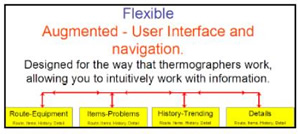 a chronic problem. Data entry needs to be in a logical but flexible rhythmic sequence that matches the pace of a thermographer as he performs the inspection. The Pocket PC has a much smaller screen size than a typical computer that must be taken into consideration when establishing how to present the data to the thermographer to work with in the field. The design must focus on the natural rhythm of the thermographer’s work flow and the size of the screen on the Pocket PC to provide a user interface that will be flexible for the different working styles of thermographers. If you do not understand that you must take these key points to task, then the software will be very tedious to work with.
a chronic problem. Data entry needs to be in a logical but flexible rhythmic sequence that matches the pace of a thermographer as he performs the inspection. The Pocket PC has a much smaller screen size than a typical computer that must be taken into consideration when establishing how to present the data to the thermographer to work with in the field. The design must focus on the natural rhythm of the thermographer’s work flow and the size of the screen on the Pocket PC to provide a user interface that will be flexible for the different working styles of thermographers. If you do not understand that you must take these key points to task, then the software will be very tedious to work with.
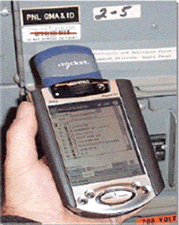 The benefit of designing a user interface based on the presentation of data on the small screen size of a Pocket PC is you will have a workable solution of office automation and data collection! You can use bar code scanners and voice annotation directly with a Pocket PC, which will greatly increase the usefulness of a Pocket PC in the field.
The benefit of designing a user interface based on the presentation of data on the small screen size of a Pocket PC is you will have a workable solution of office automation and data collection! You can use bar code scanners and voice annotation directly with a Pocket PC, which will greatly increase the usefulness of a Pocket PC in the field.
However, designing a system on office automation alone, by porting over the application from a desktop computer to automate the paper work flow method on to the small screen of the Pocket PC, is completely losing sight of the power that the Pocket PC offers to the thermographer in the field.
 |
What Thermographers are required to do in the field.
In today’s working environment, more and more emphasis is being placed on providing a professional and accountable IR program / inspection. There is specific information that the thermographer needs to know during the inspection to make sure that he is actually living up to the expectation of providing a professional service that has true accountability. The liability, both ethically and legally for his actions must always be taken seriously. There is simply too much at stake. He needs to be able to clearly have the information at hand that shows him:
Key questions that the thermographer needs to address while performing their inspection.
-
What assets/equipment are to be tested? What has been tested and not tested.
-
What is the best way to group the assets/equipment into some type of route that will
allow for a timely inspection? -
Was the equipment actually inspected in previous inspections?
-
Have there been any problems documented on a specific piece of equipment that he is testing (while he is inspecting it)? This allows him to review and reconcile past
inspection data in real time to make the appropriate determination as to the existing
problem condition. - If there are past problems that still exist (Open), are they worse (“chronic” problem
conditions)?
Database designed based on augmented user interface for the data.
None of the typical paper work flow models (either on paper or on a computer) will provide the thermographer with the kind of augmented information that he needs on a Pocket PC based on the typical questions above. The above key questions that thermographers are required to address in performing their jobs can be broken down into four basic augmented data sets, which are focused on the ability to intuitively review, reconcile, input/edit/update information during the inspection.
-
Route/equipment
-
Items/problems
-
History/trending
-
Item/problem details
These four data sets for working with information must present the data using an augmented user interface that empowers the thermographer to be able to work in a flexible and intuitive system that complements his work style and rhythm.
Microsoft Access – The clear choice for a database on the desktop and Pocket PC.
 No other database program has a larger install base worldwide than Microsoft Access. It is the first database that Microsoft has developed and clearly is the database of choice for an easy to use program that does not require someone with a background in computer programming to work with. You don’t see database administrator’s positions in companies for working with Access, as compared to SQL, Oracle and other high maintenance database programs. Access is a standard component of a suite of Microsoft office products like Word, Excel and Power Point and is easily installed and up and running right out of the box on both the desktop and Pocket PC. When choosing a database program to use, no other database has more time in the market place and is better supported by Microsoft, than Microsoft Access.
No other database program has a larger install base worldwide than Microsoft Access. It is the first database that Microsoft has developed and clearly is the database of choice for an easy to use program that does not require someone with a background in computer programming to work with. You don’t see database administrator’s positions in companies for working with Access, as compared to SQL, Oracle and other high maintenance database programs. Access is a standard component of a suite of Microsoft office products like Word, Excel and Power Point and is easily installed and up and running right out of the box on both the desktop and Pocket PC. When choosing a database program to use, no other database has more time in the market place and is better supported by Microsoft, than Microsoft Access.
Since Microsoft Access is a standard component of the Microsoft ActiveSync program for automatically synchronizing databases between your desktop computer and your Pocket PC, you will not need to install any special software to be able to transfer data between your Pocket PC and your computer as required with other database programs, and no other synchronization software program on the market today is sold more, and better supported than Microsoft’s ActiveSync (Microsoft ActiveSync is included with every Pocket PC, or you can download it for free from Microsoft!).
Augmented user interface that works the way a thermographer works in the field!
Tab navigation in the user interface is critical to the flexibility of being able to switch between Route,  Items, History, and Details, allowing the thermographer to be able to work with any information in his own natural rhythm. The Route/equipment navigational tree is the other key element in a being able to filter the data sets that are displayed on the Items, History, and Details tabs. This helped the thermographer to easily review, reconcile, and enter data on the fly, and eliminates the typical redundant data entry that leads to clerical mistakes in reports. Assets/equipment can be easily grouped into a logical route-based structure that permits the thermographer to see what needs to be tested and review any past problems.
Items, History, and Details, allowing the thermographer to be able to work with any information in his own natural rhythm. The Route/equipment navigational tree is the other key element in a being able to filter the data sets that are displayed on the Items, History, and Details tabs. This helped the thermographer to easily review, reconcile, and enter data on the fly, and eliminates the typical redundant data entry that leads to clerical mistakes in reports. Assets/equipment can be easily grouped into a logical route-based structure that permits the thermographer to see what needs to be tested and review any past problems.
1. Route / Inventory of what is to be tested.
This data set must be able to be searched both by the associated Route (proximity of other pieces of 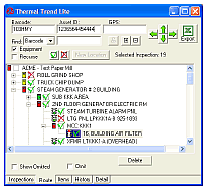 equipment that are in the approximate area to be tested), as well as by name or asset ID or GPS/GIS so that you can easily find a specific piece of equipment. It should also be able to indicate the status of any problems that have been found in the past (open or closed), as well as the equipment’s test history (for all previous inspections, not just the last year). This data set must be able to indicate if the equipment has been tested or not tested during the inspection and the ability to add, edit, omit and delete equipment and locations. Another important feature is the ability to restructure the order of the routes as necessary.
equipment that are in the approximate area to be tested), as well as by name or asset ID or GPS/GIS so that you can easily find a specific piece of equipment. It should also be able to indicate the status of any problems that have been found in the past (open or closed), as well as the equipment’s test history (for all previous inspections, not just the last year). This data set must be able to indicate if the equipment has been tested or not tested during the inspection and the ability to add, edit, omit and delete equipment and locations. Another important feature is the ability to restructure the order of the routes as necessary.
| Smart Icons™ Intuitive icons that tell you what the status of any problem that has been found. | 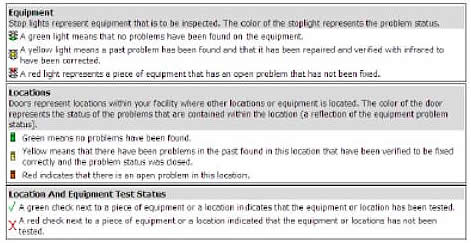 |
|
2. List of Items / Problems. This data set should be filtered by a specific location or equipment and indicate what the specific items/problems are. It should indicate all open problems (problems that have not been found to be repaired correctly) from all prior inspections, not just the last one, and indicate if there has ever been a past closed problem (Closed- ones that have been repaired correctly) so that they can be carefully reevaluated to make sure that the problem condition is not coming back (a chronic condition). |
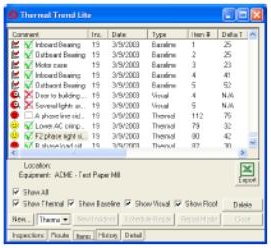 |
| 3. History of a Specific Item/Problem.
This data set shows what the past Time Over Temperature history has been for any specific problem or baseline trend that has been documented. This data set allows the thermographer perspective as to the rate of change in the problem’s severity for any problems that have a history of not being fixed by the next inspection (a chronic problem that has a life span that has covered over multiple inspections ((creating multiple incidences of the same problem record)) without being successfully repaired). This information and the ability to see past repair work orders will provide considerable perspective to the thermographer in determining what the actual problem condition is. Time Over Temperature Trending. Based on the thermal history of the Item, Thermal Problem or Baseline trending on equipment like bearings or refractory walls, it can be graphically represented in a line graph to show what the Time over Temperature trends are. This helps to illustrate graphically changing conditions that could have gone unknown to the thermographer in the field. |
 |
| 4. Details of a Specific Item/Problem
This data set is filtered by selecting a specific incident of any problem from the history tab, and provides all of the relative information on the problem condition at the time of the inspection including: temperatures, load conditions, environmental information, severity, probable cause, recommendations, thermograms and photos, as well as voice annotation stored directly with all of the problem information for review and playback at a later time. |
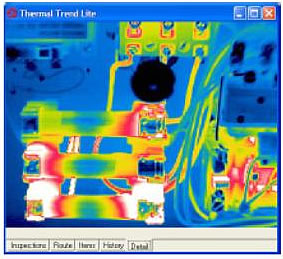 |
Reports: The benefit of office automation and data collection.
One of the most valuable benefits of using a database like Microsoft Access is that all of the data for all of the inspections resides within a database that can be easily queried to generate any type of report that you wish. You simply run a query based on the type of report you wish and Access will automatically print the report for you. You can easily create your own reports within Access or work with predefined templates to quickly generate reports.
| Samples of Typical Reports
|
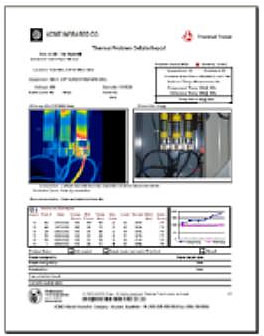 |
Exporting to CMMS programs
Another advantage of using Access is the ability to export or work directly with all of the data in other Microsoft Office applications like Word and Excel, and data can be imported directly into most CMMS programs as well. In addition, Access is an ODBC compliant database and can be accessed by other ODBC compliant programs as well.
Benefits of using a Pocket PC and a database with an augmented user interface for office automation and data collection.
-
Greatly reduces the workload on the thermographer in the field by automating the
inspection/data collection process. -
Increases the number of problems documented in the field each day by the thermographer because of automating the process of writing up problems.
-
Significantly reduces paperwork and typing errors by eliminating redundant data entry and placing the responsibility of accurate data entry into the thermographer’s hands.
-
Completely eliminates the need for someone in the office to type up reports for the thermographers or the overtime by the thermographer to type it up himself.
-
Allows for the better utilization of the thermographer to be back out in the field performing inspections versus performing office work generating reports.
-
Eliminates the long turn around time in getting a report back to the customer.
-
Significantly decreases the billing cycle by being able to invoice immediately after the inspection was performed since the report was done automatically at the end of the inspection.
-
Provides a standard platform of data sharing between different thermographers over different inspections.
-
Reduces the learning curve for new employees to be able to get into the field by having a solid system in place that actually helps to educate them while they are performing an inspection, since all of the previous inspection data is there in the field with them.
-
Allows for professional accountability practices to be established and reinforcing procedures in the manner in which the inspections are being performed and reported.
-
Greater customer retention, since a demonstrable, established IR “Program” is in place as compared to just providing the customers with a report of what is hot.
-
Allows for greater sales/accountability by providing a superior IR “Program”.
-
Ability to generate and handle more work by working smarter, not harder.
Advertisement

